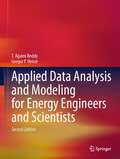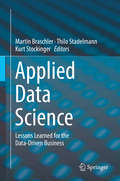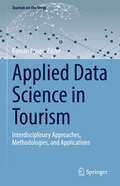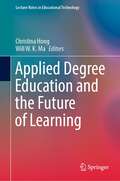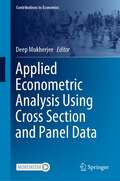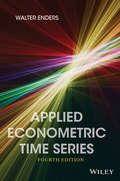- Table View
- List View
Applied Cryptography and Network Security: Third International Conference, ACNS 2005, New York, NY, USA, June 7-10, 2005, Proceedings (Lecture Notes in Computer Science #3531)
by John Ioannidis Angelos D. Keromytis Moti YungThe 3rd International Conference on Applied Cryptography and Network Security (ACNS 2005) was sponsored and organized by ICISA (the International Commu- cations and Information Security Association). It was held at Columbia University in New York, USA, June 7–10, 2005. This conference proceedings volume contains papers presented in the academic/research track. ACNS covers a large number of research areas that have been gaining importance in recent years due to the development of the Internet, wireless communication and the increased global exposure of computing resources. The papers in this volume are representative of the state of the art in security and cryptography research, worldwide. The Program Committee of the conference received a total of 158 submissions from all over the world, of which 35 submissions were selected for presentation at the a- demic track. In addition to this track, the conference also hosted a technical/ industrial/ short papers track whose presentations were also carefully selected from among the submissions. All submissions were reviewed by experts in the relevant areas.
Applied Cryptography and Network Security: 11th International Conference, ACNS 2013, Banff, AB, Canada, June 25-28, 2013. Proceedings (Lecture Notes in Computer Science #7954)
by Michael Jacobson Michael Locasto Payman Mohassel Reihaneh Safavi-NainiThis book constitutes the refereed proceedings of the 11th International Conference on Applied Cryptography and Network Security, ACNS 2013, held in Banff, Canada, in June 2013. The 33 revised full papers included in this volume were carefully reviewed and selected from 192 submissions. They are organized in topical sections on Cloud Cryptography; Secure Computation; Hash Function and Block Cipher; Signature; System Attack; Secure Implementation - Hardware; Secure Implementation - Software; Group-oriented Systems; Key Exchange and Leakage Resilience; Cryptographic Proof; Cryptosystems.
Applied Cryptography and Network Security: Second International Conference, ACNS 2004, Yellow Mountain, China, June 8-11, 2004. Proceedings (Lecture Notes in Computer Science #3089)
by Markus Jakobsson Moti Yung Jianying ZhouThe second International Conference on Applied Cryptography and Network Security (ACNS 2004) was sponsored and organized by ICISA (the International Communications and Information Security Association). It was held in Yellow Mountain, China, June 8–11, 2004. The conference proceedings, representing papers from the academic track, are published in this volume of the Lecture Notes in Computer Science (LNCS) of Springer-Verlag. The area of research that ACNS covers has been gaining importance in recent years due to the development of the Internet, which, in turn, implies global exposure of computing resources. Many ?elds of research were covered by the program of this track, presented in this proceedings volume. We feel that the papers herein indeed re?ect the state of the art in security and cryptography research, worldwide. The program committee of the conference received a total of 297 submissions from all over the world, of which 36 submissions were selected for presentation during the academic track. In addition to this track, the conference also hosted a technical/industrial track of presentations that were carefully selected as well. All submissions were reviewed by experts in the relevant areas.
Applied Cryptography and Network Security: 5th International Conference, ACNS 2007, Zhuhai, China, June 5-8, 2007, Proceedings (Lecture Notes in Computer Science #4521)
by Jonathan Katz Moti YungThis book constitutes the refereed proceedings of the 5th International Conference on Applied Cryptography and Network Security, ACNS 2007, held in Zhuhai, China, June 2007. The 31 revised full papers cover signature schemes, computer and network security, cryptanalysis, group-oriented security, cryptographic protocols, anonymous authentication, identity-based cryptography, and security in wireless, ad-hoc, and peer-to-peer networks.
Applied Cryptography and Network Security: 6th International Conference, ACNS 2008, New York, NY, USA, June 3-6, 2008, Proceedings (Lecture Notes in Computer Science #5037)
by Angelos D. Keromytis Moti Yung Steven M. Bellovin Rosario GennaroThis book constitutes the refereed proceedings of the 6th International Conference on Applied Cryptography and Network Security, ACNS 2008, held in New York, NY, USA, in June 2008. The 30 revised full papers presented were carefully reviewed and selected from 131 submissions. The papers address all aspects of applied cryptography and network security with special focus on novel paradigms, original directions, and non-traditional perspectives.
Applied Cryptography and Network Security: 9th International Conference, ACNS 2011, Nerja, Spain, June 7-10, 2011, Proceedings (Lecture Notes in Computer Science #6715)
by Javier López Gene TsudikThis book constitutes the refereed proceedings of the 9th International Conference on Applied Cryptography and Network Security, ACNS 2011, held in Nerja, Spain, in June 2011. The 31 revised full papers included in this volume were carefully reviewed and selected from 172 submissions. They are organized in topical sessions on malware and intrusion detection; attacks, applied crypto; signatures and friends; eclectic assortment; theory; encryption; broadcast encryption; and security services.
Applied Cryptography and Network Security: 13th International Conference, ACNS 2015, New York, NY, USA, June 2-5, 2015, Revised Selected Papers (Lecture Notes in Computer Science #9092)
by Tal Malkin Vladimir Kolesnikov Allison Bishop Lewko Michalis PolychronakisThis book constitutes the refereed proceedings of the 13th International Conference on Applied Cryptography and Network Security, ACNS 2015, held in New York, NY, USA, in June 2015. The 33 revised full papers included in this volume and presented together with 2 abstracts of invited talks, were carefully reviewed and selected from 157 submissions. They are organized in topical sections on secure computation: primitives and new models; public key cryptographic primitives; secure computation II: applications; anonymity and related applications; cryptanalysis and attacks (symmetric crypto); privacy and policy enforcement; authentication via eye tracking and proofs of proximity; malware analysis and side channel attacks; side channel countermeasures and tamper resistance/PUFs; and leakage resilience and pseudorandomness.
Applied Cryptography and Network Security: 14th International Conference, ACNS 2016, Guildford, UK, June 19-22, 2016. Proceedings (Lecture Notes in Computer Science #9696)
by Mark Manulis Ahmad-Reza Sadeghi Steve SchneiderThis book constitutes the refereed proceedings of the 14th International Conference on Applied Cryptography and Network Security, ACNS 2016, held in Guildford, UK. in June 2016. 5. The 35 revised full papers included in this volume and presented together with 2 invited talks, were carefully reviewed and selected from 183 submissions.ACNS is an annual conference focusing on innovative research and current developments that advance the areas of applied cryptography, cyber security and privacy.
Applied Cryptography and Network Security: 8th International Conference, ACNS 2010, Beijing, China, June 22-25, 2010, Proceedings (Lecture Notes in Computer Science #6123)
by Jianying Zhou Moti YungACNS 2010, the 8th International Conference on Applied Cryptography and Network Security, was held in Beijing, China, during June 22-25, 2010. ACNS 2010 brought together individuals from academia and industry involved in m- tiple research disciplines of cryptography and security to foster the exchange of ideas. ACNS was initiated in 2003, and there has been a steady improvement in the quality of its program over the past 8 years: ACNS 2003 (Kunming, China), ACNS 2004 (Yellow Mountain, China), ACNS 2005 (New York, USA), ACNS 2006 (Singapore), ACNS 2007 (Zhuhai, China), ACNS 2008 (New York, USA), ACNS2009(Paris,France). Theaverageacceptanceratehasbeenkeptataround 17%, and the average number of participants has been kept at around 100. The conference received a total of 178 submissions from all over the world. Each submission was assigned to at least three committee members. Subm- sions co-authored by members of the Program Committee were assigned to at least four committee members. Due to the large number of high-quality s- missions, the review process was challenging and we are deeply grateful to the committee members and the external reviewers for their outstanding work. - ter extensive discussions, the Program Committee selected 32 submissions for presentation in the academic track, and these are the articles that are included in this volume (LNCS 6123). Additionally, a few other submissionswereselected for presentation in the non-archival industrial track.
Applied Cryptography and Network Security: 4th International Conference, ACNS 2006, Singapore, June 6-9, 2006, Proceedings (Lecture Notes in Computer Science #3989)
by Jianying Zhou Moti Yung Feng BaoThis book constitutes the refereed proceedings of the 4th International Conference on Applied Cryptography and Network Security, ACNS 2006, held in Singapore in June 2006. Book presents 33 revised full papers, organized in topical sections on intrusion detection and avoidance, cryptographic applications, DoS attacks and countermeasures, key management, cryptanalysis, security of limited devices, cryptography, authentication and Web security, ad-hoc and sensor network security, cryptographic constructions, and security and privacy.
Applied Cryptography and Network Security: First International Conference, ACNS 2003. Kunming, China, October 16-19, 2003, Proceedings (Lecture Notes in Computer Science #2846)
by Jianying Zhou Moti Yung Yongfei HanThe 1st International Conference on “Applied Cryptography and Network Se- rity” (ACNS 2003) was sponsored and organized by ICISA (International C- munications and Information Security Association), in cooperation with MiAn Pte. Ltd. and the Kunming government. It was held in Kunming, China in - tober 2003. The conference proceedings was published as Volume 2846 of the Lecture Notes in Computer Science (LNCS) series of Springer-Verlag. The conference received 191 submissions, from 24 countries and regions; 32 of these papers were accepted, representing 15 countries and regions (acceptance rate of 16.75%). In this volume you will ?nd the revised versions of the - cepted papers that were presented at the conference. In addition to the main track of presentations of accepted papers, an additional track was held in the conference where presentations of an industrial and technical nature were given. These presentations were also carefully selected from a large set of presentation proposals. This new international conference series is the result of the vision of Dr. Yongfei Han. The conference concentrates on current developments that advance the - eas of applied cryptography and its application to systems and network security. The goal is to represent both academic research works and developments in - dustrial and technical frontiers. We thank Dr. Han for initiating this conference and for serving as its General Chair.
Applied Data Analysis and Modeling for Energy Engineers and Scientists
by T. Agami Reddy Gregor P. HenzeNow in a thoroughly revised and expanded second edition, this classroom-tested text demonstrates and illustrates how to apply concepts and methods learned in disparate courses such as mathematical modeling, probability, statistics, experimental design, regression, optimization, parameter estimation, inverse modeling, risk analysis, decision-making, and sustainability assessment methods to energy processes and systems. It provides a formal structure that offers a broad and integrative perspective to enhance knowledge, skills, and confidence to work in applied data analysis and modeling problems. This new edition also reflects recent trends and advances in statistical modeling as applied to energy and building processes and systems. It includes numerous examples from recently published technical papers to nurture and stimulate a more research-focused mindset. How the traditional stochastic data modeling methods complement data analytic algorithmic approaches such as machine learning and data mining is also discussed. The important societal issue related to the sustainability of energy systems is presented, and a formal structure is proposed meant to classify the various assessment methods found in the literature. Applied Data Analysis and Modeling for Energy Engineers and Scientists is designed for senior-level undergraduate and graduate instruction in energy engineering and mathematical modeling, for continuing education professional courses, and as a self-study reference book for working professionals. In order for readers to have exposure and proficiency with performing hands-on analysis, the open-source Python and R programming languages have been adopted in the form of Jupyter notebooks and R markdown files, and numerous data sets and sample computer code reflective of real-world problems are available online.
Applied Data-Centric Social Sciences: Concepts, Data, Computation, and Theory
by Aki-Hiro SatoApplied data-centric social sciences aim to develop both methodology and practical applications of various fields of social sciences and businesses with rich data. Specifically, in the social sciences, a vast amount of data on human activities may be useful for understanding collective human nature. In this book, the author introduces several mathematical techniques for handling a huge volume of data and analysing collective human behaviour. The book is constructed from data-oriented investigation, with mathematical methods and expressions used for dealing with data for several specific problems. The fundamental philosophy underlying the book is that both mathematical and physical concepts are determined by the purposes of data analysis. This philosophy is shown throughout exemplar studies of several fields in socio-economic systems. From a data-centric point of view, the author proposes a concept that may change people’s minds and cause them to start thinking from the basis of data. Several goals underlie the chapters of the book. The first is to describe mathematical and statistical methods for data analysis, and toward that end the author delineates methods with actual data in each chapter. The second is to find a cyber-physical link between data and data-generating mechanisms, as data are always provided by some kind of data-generating process in the real world. The third goal is to provide an impetus for the concepts and methodology set forth in this book to be applied to socio-economic systems.
Applied Data Science: Lessons Learned for the Data-Driven Business
This book has two main goals: to define data science through the work of data scientists and their results, namely data products, while simultaneously providing the reader with relevant lessons learned from applied data science projects at the intersection of academia and industry. As such, it is not a replacement for a classical textbook (i.e., it does not elaborate on fundamentals of methods and principles described elsewhere), but systematically highlights the connection between theory, on the one hand, and its application in specific use cases, on the other. With these goals in mind, the book is divided into three parts: Part I pays tribute to the interdisciplinary nature of data science and provides a common understanding of data science terminology for readers with different backgrounds. These six chapters are geared towards drawing a consistent picture of data science and were predominantly written by the editors themselves. Part II then broadens the spectrum by presenting views and insights from diverse authors – some from academia and some from industry, ranging from financial to health and from manufacturing to e-commerce. Each of these chapters describes a fundamental principle, method or tool in data science by analyzing specific use cases and drawing concrete conclusions from them. The case studies presented, and the methods and tools applied, represent the nuts and bolts of data science. Finally, Part III was again written from the perspective of the editors and summarizes the lessons learned that have been distilled from the case studies in Part II. The section can be viewed as a meta-study on data science across a broad range of domains, viewpoints and fields. Moreover, it provides answers to the question of what the mission-critical factors for success in different data science undertakings are. The book targets professionals as well as students of data science: first, practicing data scientists in industry and academia who want to broaden their scope and expand their knowledge by drawing on the authors’ combined experience. Second, decision makers in businesses who face the challenge of creating or implementing a data-driven strategy and who want to learn from success stories spanning a range of industries. Third, students of data science who want to understand both the theoretical and practical aspects of data science, vetted by real-world case studies at the intersection of academia and industry.
Applied Data Science in Tourism: Interdisciplinary Approaches, Methodologies, and Applications (Tourism on the Verge)
Access to large data sets has led to a paradigm shift in the tourism research landscape. Big data is enabling a new form of knowledge gain, while at the same time shaking the epistemological foundations and requiring new methods and analysis approaches. It allows for interdisciplinary cooperation between computer sciences and social and economic sciences, and complements the traditional research approaches. This book provides a broad basis for the practical application of data science approaches such as machine learning, text mining, social network analysis, and many more, which are essential for interdisciplinary tourism research. Each method is presented in principle, viewed analytically, and its advantages and disadvantages are weighed up and typical fields of application are presented. The correct methodical application is presented with a "how-to" approach, together with code examples, allowing a wider reader base including researchers, practitioners, and students entering the field. The book is a very well-structured introduction to data science – not only in tourism – and its methodological foundations, accompanied by well-chosen practical cases. It underlines an important insight: data are only representations of reality, you need methodological skills and domain background to derive knowledge from them - Hannes Werthner, Vienna University of Technology Roman Egger has accomplished a difficult but necessary task: make clear how data science can practically support and foster travel and tourism research and applications. The book offers a well-taught collection of chapters giving a comprehensive and deep account of AI and data science for tourism - Francesco Ricci, Free University of Bozen-Bolzano This well-structured and easy-to-read book provides a comprehensive overview of data science in tourism. It contributes largely to the methodological repository beyond traditional methods. - Rob Law, University of Macau
Applied Decision Analysis
by M. Lina MartínezTaking advantage of the many specialists visiting Spain prior to the INFORMS Meeting in Barcelona, hold from July 14th to July 17th 1997, we organized a work shop on Decision Analysis Applications at the Real Academia de Ciencias, Madrid, Spain, from J uly 11th to 12th 1997, under the sponsorship of de the Instituto Espaiia. This workshop had a precedent in the International Conference Decision Making: Towards the 21st Century also held at the Real Academia de Ciencias in 1993. The idea of organizing an event, this time devoted to applications of Decision Analysis, was due to Prof. Sixto Rfos, who some four years ago, .sponsored and encouraged by the Royal Academy of Sciences, was the creator of an Interdisciplinary Working Group on Decision Analysis -formed with researchers from within and outside this Academy- which has been active since then, organizing periodical meetings, and whose last project has tumed out into this Workshop. The workshop turned out to be an stimulating opportunity for communicating and discussing the enormous variety of applications of Decision Sciences. In this volume we have included most of the invited papers and a selection of refereed contributed papers. Due to the varied nature of the applications, we have grouped them into five groups ending, as way of an epilog, with a paper by Sarin which contains important insights and reftections on the nature of Decision Analysis in public and private sectors.
Applied Decision Analysis and Economic Behaviour (Advanced Studies in Theoretical and Applied Econometrics #3)
by Andrew J. Hughes HallettThe optimisation of economic systems over time, and in an uncertain environment, is central to the study of economic behaviour. The behaviour of rational decision makers, whether they are market agents, firms, or governments and their agencies, is governed by decisions designed to seeure the best outcomes subject to the perceived information and economic responses (inlcuding those of other agents). Economic behaviour has therefore to be analysed in terms of the outcomes of a multiperiod stochastic optimisation process containing four main components: the economic responses (the dynamic constraints, represented by an economic model); the objec tive function (the goals and their priorities); the conditioning information (expected exogenous events and the expected future state of the economy); and risk manage ment (how uncertainties are accommodated). The papers presented in this book all analyse some aspect of economic behaviour related to the objectives, information, or risk components of the decision process. While the construction of economic models obviously also has a vital role to play, that component has received much greater (or almost exclusive) attention elsewhere. These papers examine optimising behaviour in a wide range of economic problems, both theoretical and applied. They reflect a variety of concerns: economic responses under rational expectations; the Lucas critique and optimal fiscal or monetary poli eies; market management; partly endogenous goals; evaluating government reactions; locational decisions; uncertainty and information structures; and forecasting with endogenous reactions.
Applied Decision Support with Soft Computing (Studies in Fuzziness and Soft Computing #124)
by Xinghuo YuSoft computing has provided sophisticated methodologies for the development of intelligent decision support systems. Fast advances in soft computing technologies, such as fuzzy logic and systems, artificial neural networks and evolutionary computation, have made available powerful problem representation and modelling paradigms, and learning and optimisation mechanisms for addressing modern decision making issues. This book provides a comprehensive coverage of up-to-date conceptual frameworks in broadly perceived decision support systems and successful applications. Different from other existing books, this volume predominately focuses on applied decision support with soft computing. Areas covered include planning, management finance and administration in both the private and public sectors.
Applied Degree Education and the Future of Learning (Lecture Notes in Educational Technology)
by Christina Hong Will W. K. MaThis book draws on the responses to learning and teaching and applied education futures thinking, that provide insights into the future of learning. It brings together more than 30 novel and important applied research and scholarly contributions from around the world, including Australia, Canada, Finland, Germany, Hong Kong, Japan, Macau, Mainland China, Malaysia, Morocco, Pakistan, and the UK. The chapters, including reflective essays and practice-based case examples, are divided into five major themes:• Future ready values and competencies for the future of work• Innovative pedagogies in applied degree learning and training• Driving student access, engagement, and success through digital technologies• Intelligent technologies: Embedding the new world of work into applied degrees• Lifelong learning, partnering, and the future of workThis book is important for readers interested in international perspectives on the future of work and professional education.
Applied Degree Education and the Future of Work: Education 4.0 (Lecture Notes in Educational Technology)
by Will W. K. Ma Christina HongThis edited volume sets the stage for discussion on Education 4.0, with a focus on applied degree education and the future of work. Education 4.0 refers to the shifts in the education sector in response to Industry 4.0 where digital transformation is impacting the ways in which the world of work and our everyday lives are becoming increasingly automated. In the applied degree sector, significant change and transformation is occurring as leaders, educators and partners evolve smart campus environments to include blended learning, artificial intelligence, data analytics, BYOD devices, process automation and engage in curriculum renewal for and with industries and professions. This volume aims to profile and enhance the contribution of applied educational practice and research particularly in the applied degree sector and includes contributions that show case real world outcomes with students and industry as partners. This edited volume includes a wide range of topics, such as rethinking the role of education and educators; curriculum and the future of work; industrial partnership, collaboration and work integrated learning; vocational and professional practices; students, industry and professions as partners; employability skills and qualities for the 21st century world of work; innovative pedagogy and instructional design; adaptive learning technologies; and data analytics, assessment and feedback. The contributors come from different parts of the world in higher education, including, Canada, China, Finland, Germany, Hong Kong, Italy, Macau, Singapore and the United Kingdom.
Applied Differential Games
by A. MehlmannThis book grew out of a set of lecture notes for a one semester course on dynamic game theory held at the University of Technology, Vienna. It is intended primarily at the graduate level for students in operations research, management science, applied mathematics, and eco nomics. I hope that I have been able to give the reader an accessible introduction to the subject of nonzero-sum dif ferential games with particular emphasis on applications. It would be irrational to try to re ach total com prehensiveness in a single volume. Therefore, I have resisted the temptation to "over-cannibalize" previous textbooks and monographs on the subject. It has rather been my desire to cover material that (I think) is impor tant and interesting, but gets left out of these publications. Writing a book is quite a game. In the beginning -before c10sing the binding agreement* with Plenum-I believed this to be a fi·nite horizon game. Time, however, * Key words will be explained in the text. 7 PREFACE 8 was a merciless arbiter. I am grateful to the Senior Editor, Dr. Ken Derharn, for allowing manuscript delivery to become a (restricted) free terminal time problem. Most of all, I thank my wife Grace for offering me the needed spiritual support, and my two-year-old daughter Sabrina for ignoring the paradoxical situation that there are games which prevent Dad from playing with her.
Applied Econometric Analysis Using Cross Section and Panel Data (Contributions to Economics)
by Deep MukherjeeThis book is a collection of 20 chapters on chosen topics from cross-section and panel data econometrics. It explores both theoretical and practical aspects of selected cutting-edge techniques which are gaining popularity among applied econometricians, while following the motto of “keeping things simple”. Each chapter gives a basic introduction to one such method, directs readers to supplementary references, and shows an application. The book takes into account that—A: The field of econometrics is evolving very fast and leading textbooks are trying to cover some of the recent developments in revised editions. This book offers basic introduction to state-of-the-art techniques and recent advances in econometric models with detailed applications from various developing and developed countries. B: An applied researcher or practitioner may prefer reference books with a simple introduction to an advanced econometric method or model with no theorems but with a longer discussion on empirical application. Thus, an applied econometrics textbook covering these cutting-edge methods is highly warranted; a void this book attempts to fills.The book does not aim at providing a comprehensive coverage of econometric methods. The 20 chapters in this book represent only a sample of the important topics in modern econometrics, with special focus on econometrics of cross-section and panel data, while also recognizing that it is not possible to accommodate all types of models and methods even in these two categories. The book is unique as authors have also provided the theoretical background (if any) and brief literature review behind the empirical applications. It is a must-have resource for students and practitioners of modern econometrics.
Applied Econometric Time Series (Wiley Series in Probability and Statistics)
by Walter EndersApplied Econometric Time Series, 4th Edition demonstrates modern techniques for developing models capable of forecasting, interpreting, and testing hypotheses concerning economic data. In this text, Dr. Walter Enders commits to using a “learn-by-doing” approach to help readers master time-series analysis efficiently and effectively.
Applied Econometrics
by Dimitrios Asteriou S. G. HallThis textbook offers a unique blend of theory and practical application. Taking students from a basic level up to an advanced understanding in an intuitive, step-by-step fashion, it provides perfect preparation for doing applied econometric work. Economic tests and methods of estimation are presented clearly, and practical guidance on using several types of software packages is given. Real world data is used throughout and emphasis is given to the interpretation of the results, and the conclusions to be drawn from them in econometric work. This book will be core reading for undergraduate and Master’s students on an Economics or Finance degree, who take a course in applied econometrics. Its practical nature makes it perfect for modules requiring a research project.
Applied Econometrics
by Dimitrios Asteriou Stephen G. HallThis trusted textbook returns in its 4th edition with even more exercises to help consolidate understanding - and a companion website featuring additional materials, including a solutions manual for instructors. Offering a unique blend of theory and practical application, it provides ideal preparation for doing applied econometric work as it takes students from a basic level up to an advanced understanding in an intuitive, step-by-step fashion. Clear presentation of economic tests and methods of estimation is paired with practical guidance on using several types of software packages. Using real world data throughout, the authors place emphasis upon the interpretation of results, and the conclusions to be drawn from them in econometric work. This book will be essential reading for economics undergraduate and master's students taking a course in applied econometrics. Its practical nature makes it ideal for modules requiring a research project. New to this Edition:- Additional practical exercises throughout to help consolidate understanding- A freshly-updated companion website featuring a new solutions manual for instructors











